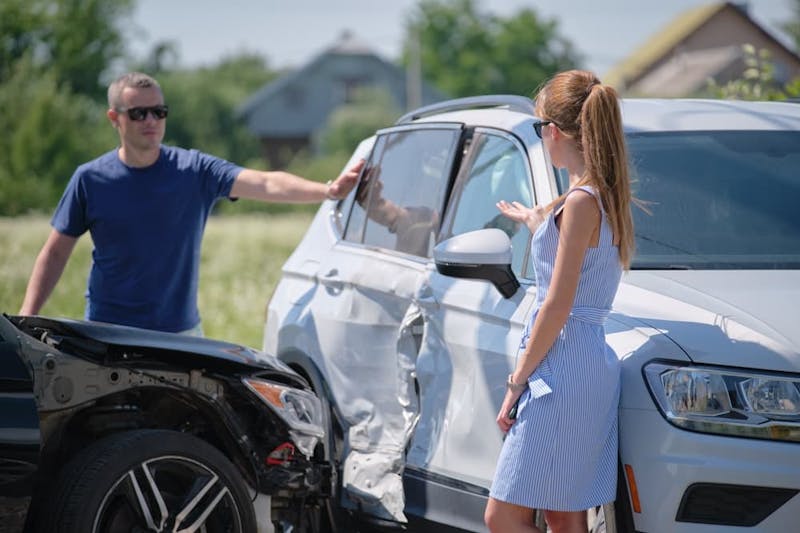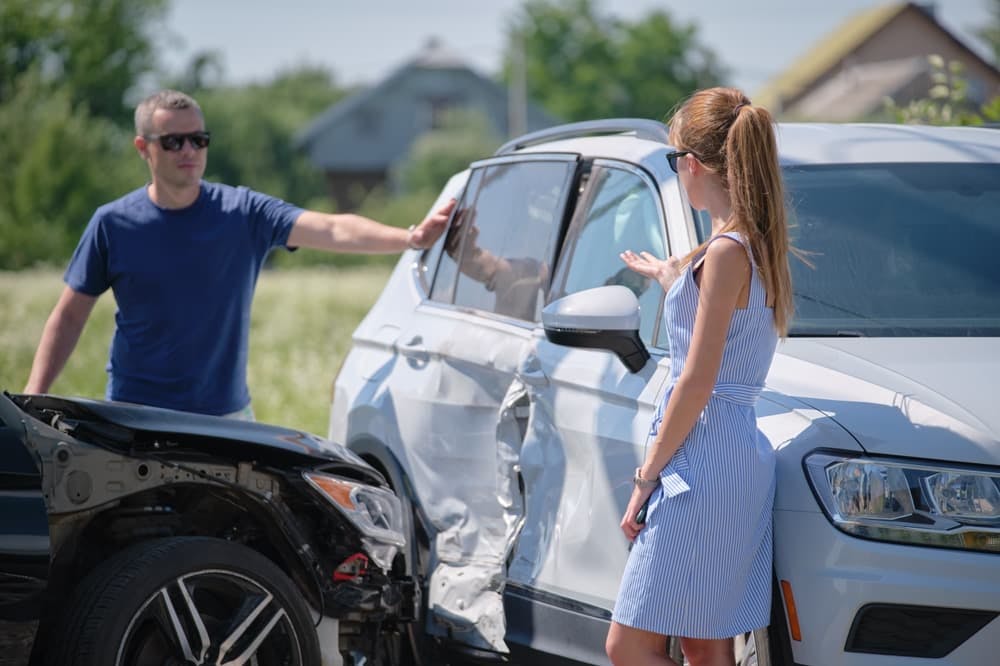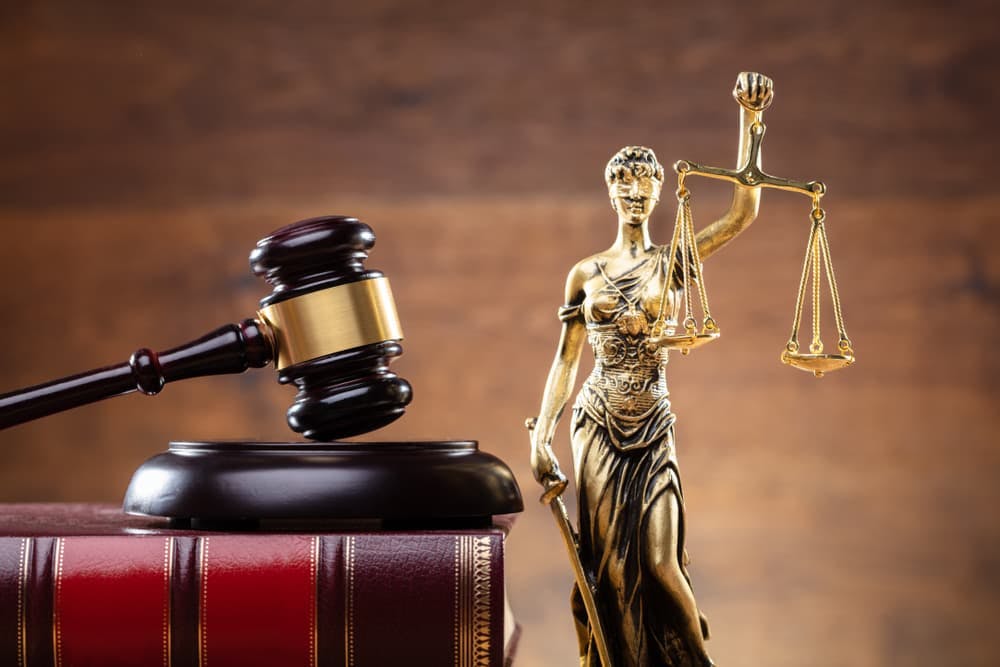Get a Free Consultation
2 minute response
24 hours a day, 7 Days a Week
Dedicated Trust Guss Intake Team

Car accidents can be stressful and confusing events. In the aftermath of a collision, determining who is at fault becomes crucial for insurance claims and potential legal action. But how can you accurately determine who hit who in a car accident? This blog post will explore the various factors that can help establish fault and why you should always consult a car accident attorney. If you are in a car accident, remember that seeking legal guidance can significantly benefit your case and ensure you receive the compensation you deserve.

Determining who hit who in a car accident may not always be straightforward. When assessing fault, multiple factors must be considered, such as traffic laws and regulations, witness statements, police reports, and expert opinions. The process involves a thorough investigation, which can be complex and time-consuming, especially for anyone who is recovering from car accident injuries.
When establishing fault in a car accident, the representation of a car accident attorney is invaluable. They can navigate through the complexities of the legal system, gather evidence, and build a solid case to support your claim. Additionally, a skilled attorney can negotiate with insurance companies on your behalf and ensure that you receive fair compensation for your injuries and damages.
Evidence plays a crucial role in determining who hit who in a car accident. The following types of evidence can help establish fault:
After a car accident, the police will often respond to the scene and create a report detailing their findings. This report includes important information such as the location, date, and time of the accident and statements from involved parties and witnesses. Police reports can provide an objective account of the incident, significantly affecting the determination of fault.
Eyewitness testimonies from individuals who witnessed the accident can provide valuable information. Their statements can help piece together the sequence of events leading up to the collision and provide an unbiased perspective on who is at fault. Eyewitness testimonies can be instrumental in proving negligence or establishing that the other party violated traffic laws.
In today's technological age, video surveillance is becoming increasingly common in public areas. In some cases, nearby surveillance cameras may have captured the car accident, providing a clear and unbiased account of the events. Video footage can be a powerful form of evidence in establishing fault, especially when witness testimonies may be contradictory. By reviewing the footage, investigators can determine which vehicle was at fault and establish who hit who.
In complex car accident cases, accident reconstruction experts may help determine fault. These professionals use scientific methods to reconstruct the accident based on available evidence, including police reports, witness statements, and physical evidence. For example, they may examine physical evidence such as tire marks, paint transfers, and vehicle damage. Accident reconstruction can provide a detailed analysis of the sequence of events, speeds, and impacts, aiding in the determination of fault. Their analysis can help establish the sequence of events and determine who hit who in the accident.
Insurance companies conduct their own investigations to determine who hit who in a car accident. They review evidence such as police reports, witness testimonies, and any other available documentation. Insurance adjusters may also take statements from the involved parties and assess the extent of damages. Based on their investigation, insurance companies make liability determinations, which can affect the outcome of any potential insurance claims or legal proceedings.
Legal proceedings, such as lawsuits, may be necessary if the parties involved in the accident cannot reach a settlement agreement. During these proceedings, evidence collected from the accident scene, police reports, witness testimonies, and expert opinions are presented to establish who hit who and determine liability.
While you may attempt to gather evidence and make a case for yourself, having a car accident attorney by your side can significantly enhance your chances of success. Here's why:

Car accident attorneys know personal injury law inside and out, including car accident principles and laws. They have an in-depth understanding of the legal process and are well-versed in the statutes and regulations that govern such cases. This knowledge allows them to navigate the legal system efficiently and effectively on your behalf.
Insurance companies are notorious for trying to minimize their payouts. They often employ various tactics to undervalue or deny claims altogether. A car accident attorney knows how to negotiate with insurance companies, ensuring you receive fair compensation for your injuries, medical expenses, property damage, and other losses.
A car accident attorney will carefully review the details of your case and gather the necessary evidence to build a solid legal argument. They will analyze the police reports, witness statements, and any other pertinent documents to establish fault and liability. By constructing a solid case, your attorney can present compelling evidence in your favor and increase your chances of a favorable outcome.
If your case proceeds to court, having a car accident attorney by your side is essential. They will represent you and advocate for your rights during trial, presenting evidence, questioning witnesses, and making persuasive arguments on your behalf. With their skills and experience, your attorney will navigate the complexities of the courtroom and work towards a favorable judgment.
Car accidents can occur in various ways, and understanding the different types of car accidents can help determine who is at fault. Here are some common types of car accidents and insights into how fault is determined in each scenario:
One of the most common types of car accidents is a rear-end collision, where one vehicle collides with the back of another vehicle. In most cases, the driver who rear-ends the other vehicle is considered at fault. This is because drivers should always maintain a safe distance and adjust their speed to avoid a collision.
However, there are exceptions to this rule. For example, if the front vehicle suddenly stops without any valid reason or the rear driver cannot stop due to hazardous road conditions, the fault may be shared or shifted entirely to the other party. It is important to have strong evidence, such as witness statements and photographs, to support your case and determine liability accurately.
Intersection accidents occur when two or more vehicles collide at an intersection. Determining fault in intersection accidents can be challenging, as it involves analyzing traffic signals, right-of-way rules, and each driver's actions. Generally, the driver who runs a red light, fails to yield, or disobeys traffic signs will be considered at fault.
But there are situations where both drivers bear some responsibility. For instance, if one driver was speeding but the other driver failed to exercise caution and yielded the right-of-way in time, liability may be divided between the parties involved.
Also known as T-bone accidents, side-impact collisions occur when the front of one vehicle crashes into the side of another vehicle at a perpendicular angle. Determining fault in side-impact collisions can be complex, as it often involves a dispute over who had the right-of-way.
However, in most cases, the driver who failed to yield or violated traffic laws by running a stop sign or red light will be held responsible. To establish fault, you must gather evidence such as witness statements, traffic surveillance footage, or photographs of the accident scene.
Single-vehicle accidents involve only one vehicle and occur when a driver loses control and crashes into a stationary object, such as a tree, building, or utility pole. In this type of accident, the driver is typically considered at fault. However, there are situations where external factors may contribute to the accident. Poor road conditions, hazardous road designs, or vehicle defects can alleviate or shift the blame from the driver to a third party, such as the municipality or automobile manufacturer. Consult with an attorney to evaluate your case and determine the potential liability in single-vehicle accidents.
Understanding the different types of car accidents can provide valuable insights when determining fault. However, the determination of fault can vary depending on the specific circumstances of each accident. Consulting with an experienced attorney can navigate the legal process effectively and maximize your chances of receiving the compensation you deserve.
Determining fault in a car accident is crucial when seeking compensation for injuries and damages. Insurance companies and legal professionals rely on established principles to determine who is at fault in a car accident.
These principles, known as the elements of negligence, provide a framework for evaluating the actions and responsibilities of each party involved. When you meet with a car accident attorney to discuss your case, they will assess the circumstances of your accident and determine if you have a valid claim.
The first element of negligence is the duty of care. Every driver has a duty to drive safely and responsibly. This means following traffic laws, maintaining control of the vehicle, and being aware of their surroundings. When drivers fail to uphold this duty of care and their actions lead to an accident, they may be considered negligent.
The second element is a breach of duty. A breach of duty occurs when a driver fails to meet the standard of care expected of them. This can include anything from distracted driving, speeding, or disregarding traffic signals. If you can prove the driver's actions deviated from what a reasonable person would have done in the same situation, you will show a breach of duty.
Causation is the third element of negligence. There must be a direct link between the driver's breach of duty and the accident itself to establish fault. This means that the driver's actions must have been the cause of the accident and any resulting injuries or damages. Victims must present evidence, such as witness statements, photographs, and police reports, to establish this link.
The final element is damages. To have a valid claim, you must have suffered actual damages due to the accident. This can include physical injuries, property damage, medical expenses, and lost income. By quantifying your damages, you can better determine the compensation you are entitled to.
By using these elements of negligence, insurance companies and legal professionals can objectively assess the actions and responsibilities of each party involved in a car accident. This allows them to determine fault and allocate appropriate compensation.
If you have been in a car accident, consult an experienced attorney who can guide you through this process and protect your rights. They can gather evidence, negotiate with insurance companies, and advocate for your best interests, ultimately helping you seek the compensation you deserve.

Establishing fault in a car accident is vital for insurance claims and legal proceedings. However, seeking legal representation from a car accident attorney is crucial to ensure a strong case and fair compensation. Determining who hit who in a car accident requires a thorough investigation and the skills and experience of a knowledgeable car accident attorney.
If you suffered injuries in a car accident, seek legal assistance. You need professional guidance and dedicated representation from an experienced personal injury lawyer who can navigate the legal process, establish fault, and fight for the compensation you deserve. Don't face the aftermath of a car accident alone - reach out to an attorney today for a free consultation.
Case evaluations are free with no obligation to hire a lawyer. They can answer your questions and assess your legal options, shedding light on the legal process and what you might expect. If you choose to proceed, you put your entire claim in your lawyer’s hands, freeing your time and energy to focus on your physical recovery.
2 minute response
24 hours a day, 7 Days a Week
Dedicated Trust Guss Intake Team